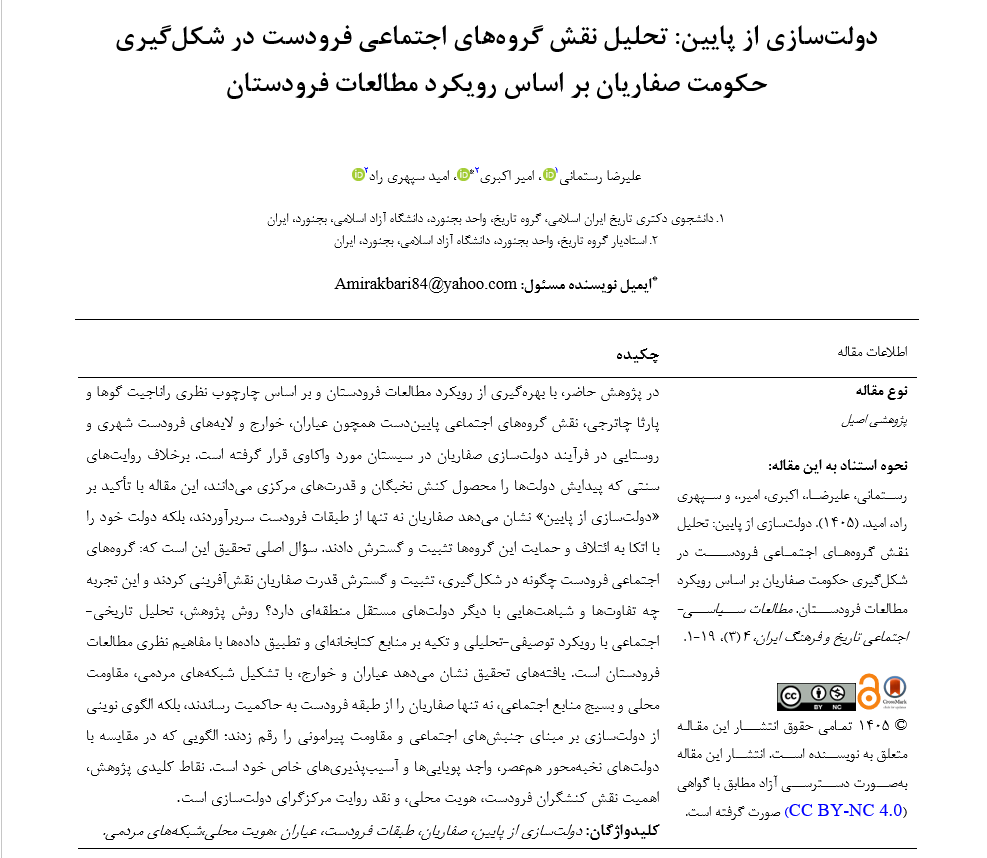دولتسازی از پایین: تحلیل نقش گروههای اجتماعی فرودست در شکلگیری حکومت صفاریان بر اساس رویکرد مطالعات فرودستان
کلمات کلیدی:
دولتسازی از پایین, صفاریان, طبقات فرودست, عیاران, هویت محلی, شبکه های مردمیچکیده
در پژوهش حاضر، با بهرهگیری از رویکرد مطالعات فرودستان و بر اساس چارچوب نظری راناجیت گوها و پارثا چاترجی، نقش گروههای اجتماعی پاییندست همچون عیاران، خوارج و لایههای فرودست شهری و روستایی در فرآیند دولتسازی صفاریان در سیستان مورد واکاوی قرار گرفته است. برخلاف روایتهای سنتی که پیدایش دولتها را محصول کنش نخبگان و قدرتهای مرکزی میدانند، این مقاله با تأکید بر «دولتسازی از پایین» نشان میدهد صفاریان نه تنها از طبقات فرودست سربرآوردند، بلکه دولت خود را با اتکا به ائتلاف و حمایت این گروهها تثبیت و گسترش دادند. سؤال اصلی تحقیق این است که: گروههای اجتماعی فرودست چگونه در شکلگیری، تثبیت و گسترش قدرت صفاریان نقشآفرینی کردند و این تجربه چه تفاوتها و شباهتهایی با دیگر دولتهای مستقل منطقهای دارد؟ روش پژوهش، تحلیل تاریخی-اجتماعی با رویکرد توصیفی-تحلیلی و تکیه بر منابع کتابخانهای و تطبیق دادهها با مفاهیم نظری مطالعات فرودستان است. یافتههای تحقیق نشان میدهد عیاران و خوارج، با تشکیل شبکههای مردمی، مقاومت محلی و بسیج منابع اجتماعی، نه تنها صفاریان را از طبقه فرودست به حاکمیت رساندند، بلکه الگوی نوینی از دولتسازی بر مبنای جنبشهای اجتماعی و مقاومت پیرامونی را رقم زدند؛ الگویی که در مقایسه با دولتهای نخبهمحور همعصر، واجد پویاییها و آسیبپذیریهای خاص خود است. نقاط کلیدی پژوهش، اهمیت نقش کنشگران فرودست، هویت محلی، و نقد روایت مرکزگرای دولتسازی است.
دانلودها
مراجع
Abbasi, M. (2009). Local Identity in Sistan and the Saffarid State. Identity and Culture, 9(3), 35-54.
Bastani Parizi, M. E. (2004). Sistan in Iranian History. Elm.
Bosworth, C. E. (1994). The Saffarids of Sistan and the Sistan of the Saffarids. In The Cambridge History of Iran (Vol. 4, pp. 90-129). Cambridge University Press.
Bosworth, C. E. (2013). The Saffarids (Translated by G. Sahab ed.). Afshar Endowments Foundation.
Chatterjee, P. (2004). The Politics of the Governed: Reflections on Popular Politics in Most of the World. Columbia University Press.
Daniel, E. L. (1989). The Political and Social History of Khurasan under Abbasid Rule. Bibliotheca Islamica.
Dehbashi, H. (2015). The Culture of Resistance in Iran. Institute for Humanities and Cultural Studies.
Eskandari, Y. (2016). The Popular Legitimacy of the Saffarid State in Islamic Sources. Civilization Studies, 2(7), 15-32.
Farrokh, M. H. (2011a). Popular Movements and Local States in Iran. Ettela'at.
Farrokh, M. H. (2011b). Transformations in the Social Structure of Sistan in the Saffarid Era. Human Sciences Research Journal, 2(3), 65-85.
Fayyaz, I. (2016). Social Capital in Iran. Research Institute of Culture, Art, and Communication.
Ghaderi, I. (2019). The Kharijites of Sistan and Their Impact on the Social Transformations of the Saffarid State. Islamic History and Iran, 15(1), 33-52.
Ghanbari, Z. (2018). Local Democracy and the Role of the Subalterns in Iranian State-Building Before the Mongols. Institute for Humanities Research.
Guha, R. (1982). On Some Aspects of the Historiography of Colonial India. In Subaltern Studies I: Writings on South Asian History and Society. Oxford University Press.
Hobsbawm, E. J. (1959). Primitive Rebels: Studies in Archaic Forms of Social Movement in the 19th and 20th Centuries. Manchester University Press.
Jamshidi, H. (2021). Rereading the Social Capital Theory in Local State-Building of Sistan. Historical Sociology, 1(1), 43-61.
Jamshidi, J. (2021). The Subalterns and the State in Iranian History. Agah.
Karimi, M. J. (2019). The Ayyaran and the Structure of Local Power in Saffarid Sistan: A Comparative Study. Naqd-e Farhang.
Malayeri, M. (1993). The Sociology of the Ayyaran in Medieval Iran. Toos.
Modarresi Tabatabaei, S. J. (2001). Investigating the Role of the Kharijites in the Saffarid State. Historical Research Journal, 4(1), 75-91.
Moftakhari, M. (2000). The Kharijites and Their Role in the Transformations of the Early Islamic Centuries. Ney.
Mohammadkhani, A. (2022). Subaltern Studies and New Iranian Historiography. Ney.
Mousavi, A. (2021). Indigenous State-Building in Iran: A Case Study of the Saffarids of Sistan. Ferdowsi University of Mashhad.
Onsor al-Maali, K. i. I. (2004). Qabus-nameh (Corrected by G. H. Yousefi ed.). Kharazmi.
Ravandi, M. (2003). The Social History of Iran (Vol. 2). Amir Kabir.
Saberi, A. (2012). Investigating the Social and Political Grounds for the Emergence of the Saffarids Ferdowsi University of Mashhad].
Safa, Z. (1999). History of Iranian Literature (Vol. 1). Ferdous.
Samiee, R. (2014). A Comparison of Saffarid and Buyid State-Building. Islamic History Research Journal, 14(2), 87-104.
Scott, J. C. (1985). Weapons of the Weak: Everyday Forms of Peasant Resistance. Yale University Press.
Shojaei Saen, S. Z. S. (1997). A Sociological Analysis of the Saffarids. Islamic History and Iran(22), 35-50.
Taherkhani, H. (2013). Popular Resistance and the Role of Ayyaran Networks in Saffarid State-Building. Historical Research Journal, 8(2), 90-105.
Tajik, N. (2022). Rethinking Collective Identity and State-Building in Sistan: From Pre-Islamic Era to the Saffarids. Mahris.
Zarrinkoub, A. (2003). History of Iran After Islam. Amir Kabir.

دانلود
چاپ شده
ارسال
بازنگری
پذیرش
شماره
نوع مقاله
مجوز
حق نشر 2025 علیرضا رستمانی (نویسنده); امیر اکبری; امید سپهری راد (نویسنده)

این پروژه تحت مجوز بین المللی Creative Commons Attribution-NonCommercial 4.0 می باشد.







